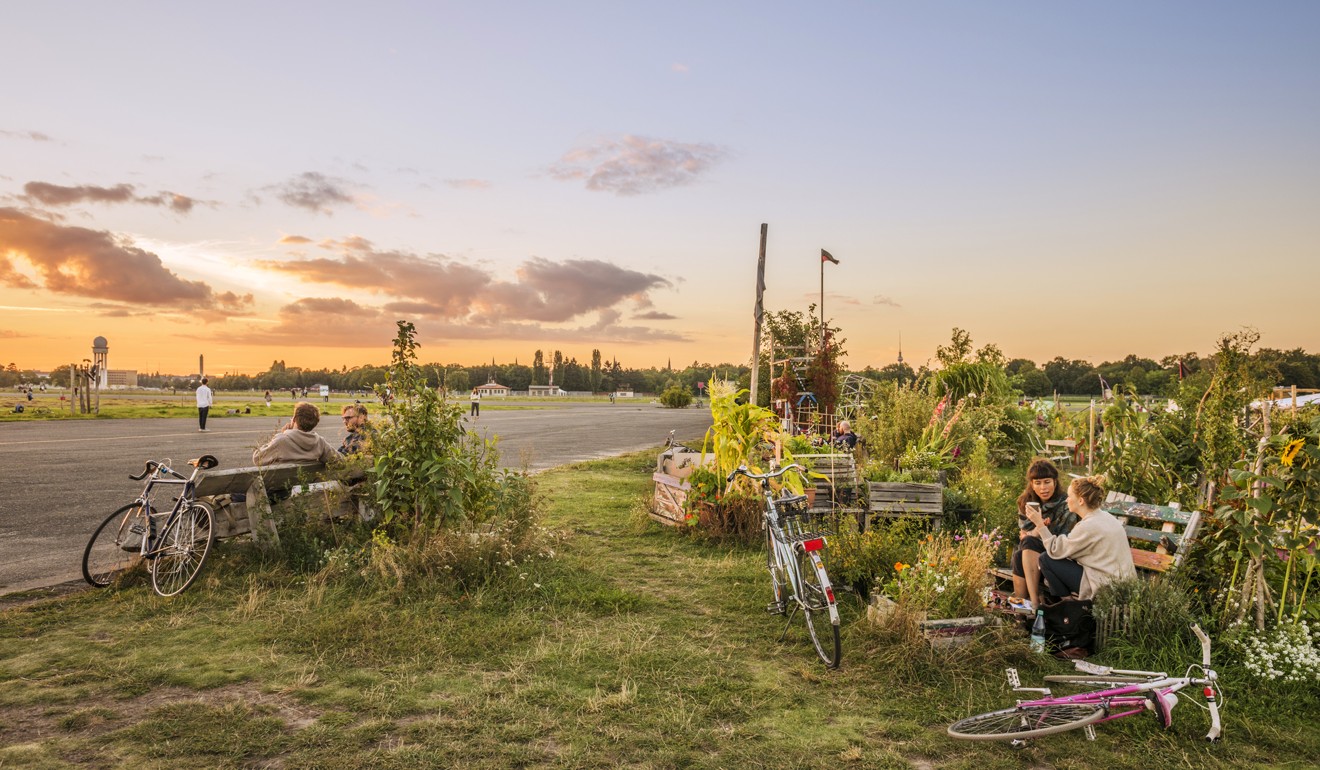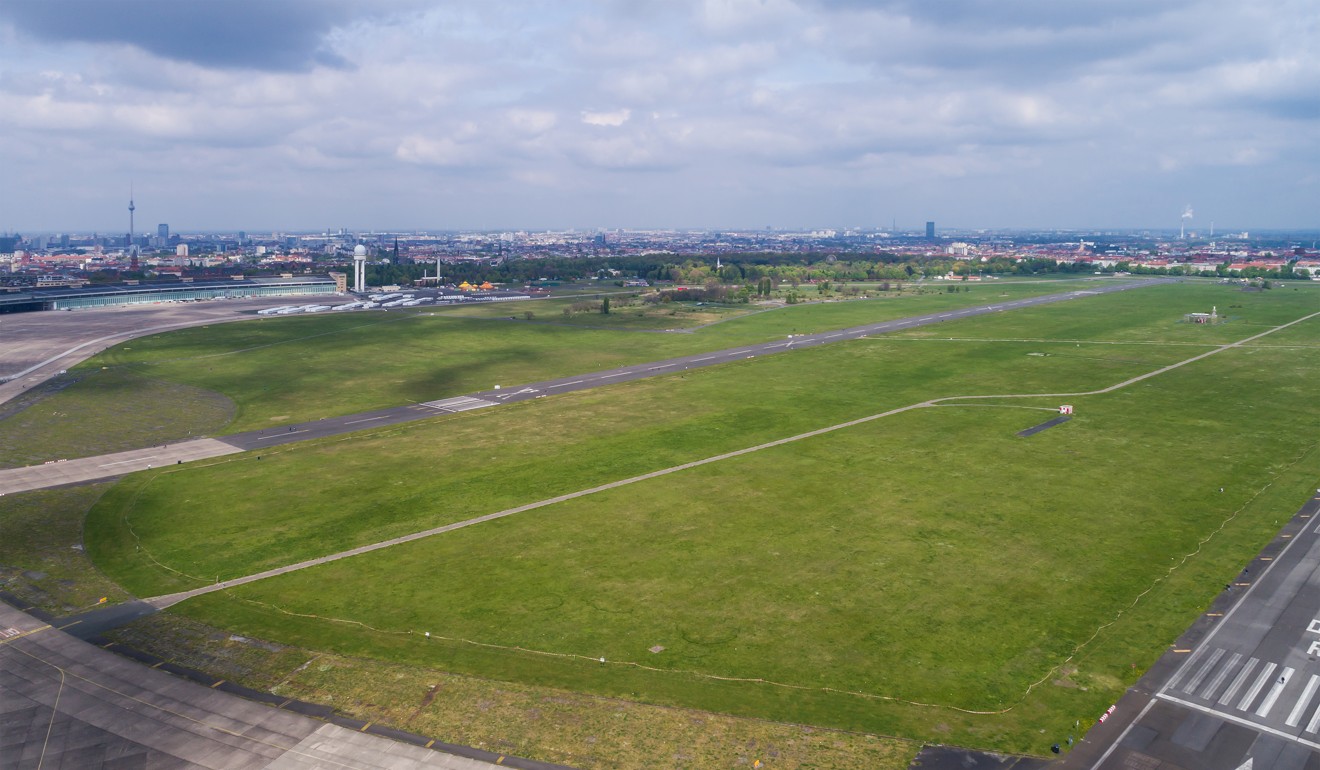
What Hong Kong can learn from an old Berlin airport on bottom-up city planning
- Tempelhof Field is a green haven of public space that was spared development after authorities listened to voice of the people
- Experts point out the smartest method in smart city planning may not always be about technology
Tempelhof Field in south-central Berlin is the first stop Jonas Schorr shows to visitors, as an example of how bottom-up city planning ties into the development of a smart city.
“Sometimes, the smartest solutions have nothing to do with technology,” says the Berlin native and freelance smart city consultant who helps city managers navigate this novel and sometimes arbitrary field.
The sprawling Tempelhof Airport, which has a history dating back to the Nazi era, is indeed an urban planning and public space wonder of sorts.

In the summer, families armed with deckchairs and sunshades hold picnics by old taxiways and grassy lawns spread out across 386 hectares of open public space. Barbecues, music festivals, dog walks, concerts and cycling are among the popular activities. A large swathe was requisitioned by the government in 2015 to house refugees.
The site has been eyed for redevelopment since the airport ceased operations just over a decade ago.
American cosmetics giant Estee Lauder proposed turning it into a high-end beauty centre. Another idea was for a 1,000-metre artificial mountain with landscaped, snow-covered ski slopes. Neither plan took off.
Time for Hong Kong government to get smart about modernising city: think tank
In 2011, city planners came up with the pragmatic proposal for a commercial and residential development that would provide 4,700 homes.
But Berliners said no.
In 2014, they forced a city referendum and voted with two-thirds majority to leave the site alone as a public park. It is now known as Tempelhofer Freiheit, or Tempelhof Freedom.
“There was incredible vibrancy in the whole debate and it was all very bottom-up driven,” Schorr said.
There was incredible vibrancy in the whole debate and it was all very bottom-up driven
“From a real estate perspective, be it Hong Kong, Singapore or London, it is probably quite rare that a city allows itself to keep so much space simply empty.
“When we talk about smart city development, the smartest way to look at something is from the perspective of users, which in this case, was the citizens. There needs to be a process of co-creation from the early stages.”
Tempelhof epitomises how Berliners have made clear that they want their voices heard, regardless of the ambitions city planners may have.
As Berlin expands, concerns have risen over gentrification, shrinking of public spaces and more crowded parks. Keeping Tempelhof open helped ease some of these pressures.
Despite all the talk about electric vehicles and autonomous cars, Berliners have in recent years petitioned successfully for better bicycle infrastructure, and a new mobility law that mandates bike lanes on all major and minor roads.
The Post was in Berlin late last year to look at what the German capital was doing to promote its version of a smart city – and the lessons for Hong Kong.

On the surface, the German capital is pushing all the right buttons. More than 100 companies and science and research institutes are now involved in promoting Berlin as a smart city under a comprehensive working group coordinated by Berlin Partner, a public-private partnership tasked with marketing the city to the world.
Although the city has no dedicated smart city budget, public grants come from federal ministries, the EU as well as the private sector.
Its start-up lab culture is thriving. Research clusters are looking at smart solutions to real city issues – traffic congestion, resource management, crowded living spaces and reducing carbon emissions to combat climate change.
Opinion: Hong Kong’s smart city ambitions must be powered by tech-savvy people
Companies at the 55,000 square metre EUREF Campus, a science park-type “intelligent city”, have been pouring resources into practical energy, sustainability and e-mobility research that can be applied in the city.
Harnessing its own renewable energy grid, the park has already achieved government climate targets for the year 2050. Driverless electric vans are now seen on its streets.
Meanwhile, research centres like the German Institute of Urban Affairs focus on issues municipalities must deal with, such as urban development and construction in an old, historic city like Berlin.
At Tempelhof, new businesses have begun moving into the largely empty former airport terminal building, with plans to turn it into a hub for creative businesses and smart city-focused start-ups.
Not all about technology
The hallmarks of a smart city often revolve around concepts such as connectivity, big data and the “internet of things” with leading cities such as Shenzhen, Singapore and Seoul often springing to mind. The phrase refers to the interconnection between computing devices in everyday objects.
But some experts in Berlin warn that any city would be headed in the wrong direction if it placed too much emphasis on technology and too little on public participation.
There is a natural tendency to assume that it is all about technology, often driven by the private sector, according to Dr Jens Libbe, head of infrastructure, economy and finance at the Berlin-based German Institute of Urban Affairs, an applied research and urban development consultancy that advises the city government.
All too often, he said, big tech companies would rush to shove the latest technologies down a city’s throat without considering what was really needed.
“To them, cities are future markets. But they’ll have to learn what the best applications are.
To them, cities are future markets. But they’ll have to learn what the best applications are
The industry must accept that Berlin has this long tradition of self-government, city planning and public participation,” he said.
He stressed that “smart cities are means and tools, not ends and outcomes. Technology is only one part of urban development. We should be “smart in a critical way to find applicable solutions”.
Germany is considered somewhat a laggard among European countries in smart city initiatives, but Berlin is seeking to promote a version of the concept that puts its residents first.
While technology is an inescapable aspect of developing a smart city, Berlin sees improving public life and fostering public participation as equally important.
Berlin’s Smart City Strategy, unveiled in 2014, stressed the need to involve citizens and investors in “the shaping of the city to make it attractive, viable for the future, resilient and dedicated to the common good, thus increasing the quality of life”.
Hong Kong’s smart city vision in a fog amid fight over 5G bandwidth access
Germany’s national Smart City Charter was launched three years later, setting guidelines for a digital transformation, with goals and strategies for the application of infrastructure and big data, while emphasising transparency, democratisation and “co-creation”.
A smarter city, it said, would strengthen the ability of municipalities to act intelligently, while still respecting human rights and increasing public participation and democracy.
One ongoing smart city-focused project that embodies this ethos is the BrainBox by researchers at the Technical University of Berlin’s Chora Conscious City Labs.
While mostly used for research and not available commercially yet, the project aims to empower citizens by giving them the opportunity to participate in city planning.
It involves setting up a mobile structure in a public space, where people can gather around an interactive screen, or “discussion island”, to look at various choices for planning a smarter, greener Berlin.
These “scenario games” are often played around a map of Berlin loaded with important data ranging from demographics, health services, water sources, to utilities, electric cars and the power grid.
People can consider the trade-offs as they choose what they prefer for their city and what they are prepared to give up.
“Conscious City Lab allows people to come together to negotiate their own future,” says Immo Janssen, who works on sustainable urban planning and urban design at the lab. “It creates an environment where all urban projects are planned bottom-up”.
A smart city may need to embrace information and communications technology, but planners stress that it is about applying technology to finding better solutions for people.
Why Hong Kong lags behind
As Hong Kong implements its own smart city blueprint, these are lessons to keep in mind.
Launched in 2017, the blueprint says the city should embrace innovation and technology to build a “‘Smart Hong Kong’ characterised by a strong economy and high quality of living”, and “built upon the needs of the people”. The fruits of this plan “should be seen and felt by residents and visitors”.
Pauline Ng Man-wah, who heads the Hong Kong Policy Research Centre of the local think tank Tianda Institute, said the problem with smart city development in Hong Kong was the lack of public buy-in.
“One of the major barriers we have identified is the lack of understanding among general citizens on the need to become a smart city, and what they are expected to contribute, or how they might benefit,” she said in a report last year.
“Many people think it is only about information technology, and that it has nothing to do with them. The government has failed to get them to realise that turning Hong Kong into a smart city is a common goal which requires everyone’s participation.
Turning Hong Kong into a smart city is a common goal which requires everyone’s participation
She added: “Stakeholders must be willing to change with you. You need to convince them. As citizens, they need to feel that they are moving forward. That’s why it is important for small successes rather than grand schemes. They need to see how they can benefit from smart cities.”
For small battles, she cited the example of how the Hospital Authority could consider integrating all data between public hospitals to make it easier for patients to book appointments and avoid long waits at emergency rooms.
As Berlin’s Tempelhof airfield showed, the most optimal smart city solutions can come from ordinary residents of a city.
“Smart city planning should aim to enhance user experience and improve the quality of living, both environmentally and socially,” said Kathy Ip Tsz-ying, secretary general of the Hong Kong Public Space Initiative, a non-profit think tank.

She praised the bottom-up planning of public spaces such as Tempelhof as well as New York’s High Line, a public park built on a disused freight rail line.
“The most fundamental purpose of public space is to effectively catalyse public life. It is hence imperative that the design and management of public space has to be people-oriented, encouraging public use, which should be the rule of thumb of smart city planning,” Ip said.
“Bottom-up planning is fundamental in public space management for a smart, people-centric city. Only when the community is engaged and empowered can a tailor-made public space be achieved. Unfortunately, Hong Kong is lagging behind.”

